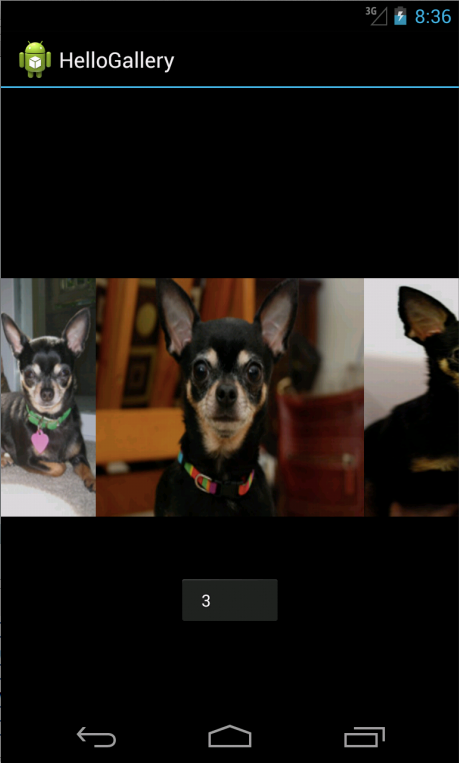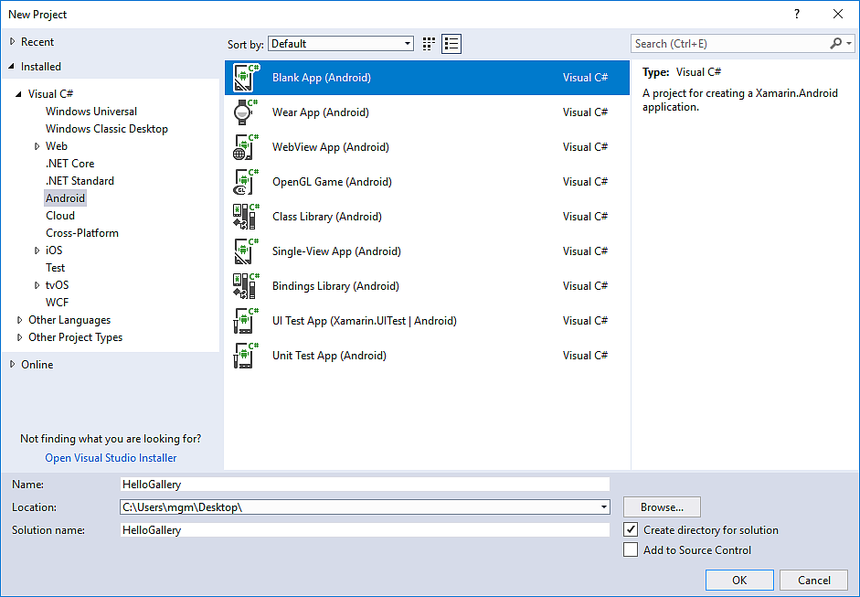Xamarin.Android Gallery control
Gallery
is a layout widget used to display items in a horizontally scrolling
list and positions the current selection at the center of the view.
Important
This widget was deprecated in Android 4.1 (API level 16).
In this tutorial, you'll create a gallery of photos and then display a toast message each time a gallery item is selected.
After the Main.axml layout is set for the content view, the Gallery
is captured from the layout with
FindViewById.
The
Adapter
property is then used to set a custom adapter ( ImageAdapter) as the
source for all items to be displayed in the dallery. The ImageAdapter
is created in the next step.
To do something when an item in the gallery is clicked, an anonymous
delegate is subscribed to the
ItemClick
event. It shows a
Toast
that displays the index position (zero-based) of theselected item (in a
real world scenario, the position could be used to get the full sized
image for some other task).
First, there are a few member variables, including an array of IDs that reference the images saved in the drawable resources directory (Resources/drawable).
Next is the class constructor, where the
Context
for an ImageAdapter instance is defined and saved to a local field.
Next, this implements some required methods inherited from
BaseAdapter.
The constructor and the
Count
property are self-explanatory. Normally,
GetItem(int)
should return the actual object at the specified position in the
adapter, but it's ignored for this example. Likewise,
GetItemId(int)
should return the row id of the item, but it's not needed here.
The method does the work to apply an image to an
ImageView
that will be embedded in the
Gallery
In this method, the member
Context
is used to create a new
ImageView.
The
ImageView
is prepared by applying an image from the local array of drawable
resources, setting the
Gallery.LayoutParams
height and width for the image, setting the scale to fit the
ImageView
dimensions, and then finally setting the background to use the
styleable attribute acquired in the constructor.
See ImageView.ScaleType
for other image scaling options.
Walkthrough
Start a new project named HelloGallery.
Find some photos you'd like to use, or download these sample images. Add the image files to the project's Resources/Drawable directory. In the Properties window, set the Build Action for each to AndroidResource.
Open Resources/Layout/Main.axml and insert the following:
<?xml version="1.0" encoding="utf-8"?>
<Gallery xmlns:android="http://schemas.android.com/apk/res/android"
android:id="@+id/gallery"
android:layout_width="fill_parent"
android:layout_height="wrap_content"
/>
Open MainActivity.cs and insert the following code for the
OnCreate()
method:
protected override void OnCreate (Bundle bundle)
{
base.OnCreate (bundle);
// Set our view from the "main" layout resource
SetContentView (Resource.Layout.Main);
Gallery gallery = (Gallery) FindViewById<Gallery>(Resource.Id.gallery);
gallery.Adapter = new ImageAdapter (this);
gallery.ItemClick += delegate (object sender, Android.Widget.AdapterView.ItemClickEventArgs args) {
Toast.MakeText (this, args.Position.ToString (), ToastLength.Short).Show ();
};
}
Create a new class called ImageAdapter that subclasses
BaseAdapter:
public class ImageAdapter : BaseAdapter
{
Context context;
public ImageAdapter (Context c)
{
context = c;
}
public override int Count { get { return thumbIds.Length; } }
public override Java.Lang.Object GetItem (int position)
{
return null;
}
public override long GetItemId (int position)
{
return 0;
}
// create a new ImageView for each item referenced by the Adapter
public override View GetView (int position, View convertView, ViewGroup parent)
{
ImageView i = new ImageView (context);
i.SetImageResource (thumbIds[position]);
i.LayoutParameters = new Gallery.LayoutParams (150, 100);
i.SetScaleType (ImageView.ScaleType.FitXy);
return i;
}
// references to our images
int[] thumbIds = {
Resource.Drawable.sample_1,
Resource.Drawable.sample_2,
Resource.Drawable.sample_3,
Resource.Drawable.sample_4,
Resource.Drawable.sample_5,
Resource.Drawable.sample_6,
Resource.Drawable.sample_7
};
}
Run the application. It should look like the screenshot below:

References
Portions of this page are modifications based on work created and shared by the Android Open Source Project and used according to terms described in the Creative Commons 2.5 Attribution License.
